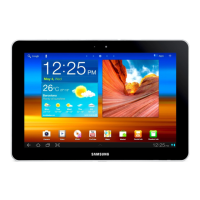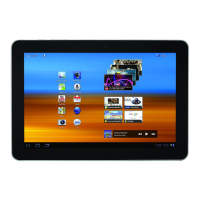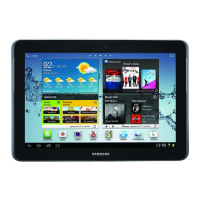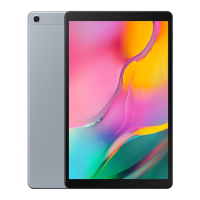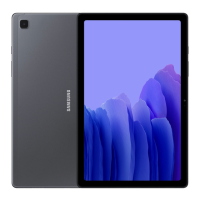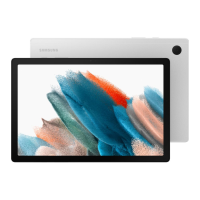Do you have a question about the Samsung Galaxy Tab 10.1 and is the answer not in the manual?
Explains manual structure, safety info, and navigation based on default settings.
Details about the SIM card, its function, and caution during handling.
Information about the device's rechargeable Li-Ion battery and charging.
Instructions on how to power the device on and off.
Steps for initial device setup, including language selection and starting the process.
Overview of device navigation using command buttons and touch screen.
Explains how notifications appear in the system bar and how to view them.
Describes the Status Bar area showing current date, time, battery, and connectivity status.
Allows viewing and controlling common settings and accessing the complete Settings application.
Explains the System Bar and icons showing notifications, battery power, and connection details.
Shortcuts to common features found on the Home screen by default.
Self-contained applications that can be placed on Home screens for quick access.
Shortcuts to common applications.
Information on customizing display screen settings.
Shortcuts to frequently used apps like Alarm, Calculator, etc.
Displays all installed applications in a customizable grid.
Lists preloaded applications and their functions.
Describes the three text input methods available: Android Keyboard, Google voice typing, and Samsung keyboard.
Steps to select and activate a text input method when entering text.
Information about active applications and RAM manager in the pop-up.
Lists key features of the device, including screen size, OS version, and connectivity.
Details on messaging capabilities like Gmail, Email, and Google Talk.
Supported image formats for the photo gallery.
Supported container and codec types for video playback.
Information about DivX video playback capabilities.
Supported audio file formats for the music player.
Supported ringtone formats.
Details on RAM and on-board memory capacity.
How to search the tablet and web by typing or speaking.
The starting point for using the device, allowing customization.
Shortcuts to common applications.
Indicates which Home screen is being displayed.
Applications that run on the Home screen.
How to select or launch items by tapping them.
How to activate on-screen items by touching and holding them.
How to navigate by swiping, flicking, or sliding fingers across the screen.
How to display the central Home screen or Task Manager pop-up.
How to open a list of thumbnail images of recently worked apps.
A softkey that can launch different applications or screen capture.
Shortcuts to common features found on the Home screen.
Shortcuts to apps usable anytime, like calendar or calculator.
How to customize the Home screen by removing or adding panels.
How to return to the previous screen, option, or step.
How to display the central Home screen.
How to open a list of thumbnail images of recently worked apps.
How to search the Web.
How context-sensitive menus offer options for features or screens.
How to adjust view for applications designed for smaller screens.
How to check for and update preloaded applications from Google Play.
Online access to account information, billing, and service plans.
How to set alarms for reminders or wake-up times.
Allows streaming photos, music, and videos to DLNA certified devices.
Mobile application for access to the online Amazon website.
Provides access to a built-in HD racing video game.
eReading application for presenting eBooks.
Provides basic arithmetic functions and advanced operators.
Helps organize schedules, manage events and tasks, and set alarms.
Instructions on taking photos and recording videos using the device's camera.
How to save and manage contact information.
How to view, reopen, or delete downloaded files and apps.
Provides access to desktop files directly from the device.
How to send and receive email from the device.
How to find, view, and manage folders and files.
How to view and manage photos and videos stored on the device.
Enables device for T-Mobile broadband for high-speed data access.
How to send and receive email with Gmail.
How to share updates and photos with Google+ for mobile.
How to access the Internet using the full HTML browser.
How to locate friends on a map and share or hide location.
Displays company logos on Google Maps for locating businesses.
Provides mobile device-specific security features.
How to find current location, get directions, and location-based information.
Access to movies and TV shows for rent or purchase.
How to create and manage text memos.
How to send and receive text and multimedia messages.
How to bring groups of friends together for conversations.
Organizes family calendar, shopping list, To-Do list, and journals.
How to play music and other audio files.
How to find destinations and get walking or driving directions.
How to create and manage memos by typing or drawing.
How to crop, rotate, resize, and edit photos.
How to read eBooks from the Google Play Books service.
How to rent and watch movies from Google Play.
How to browse, shop, and play songs from Google Play.
How to browse, download, and install applications and games.
Access to compatible productivity tools.
How to view news in bite-sized pieces.
How to create and save documents and view PDFs.
How to search the Web using the Google search engine.
How to configure the device to user preferences.
Provides a virtual QWERTY keyboard similar to Samsung's.
Uses voice to enter text recognized by the device.
A virtual QWERTY keypad with predictive text.
A text input method using gliding finger over the keypad.
Steps to select and activate a text input method when entering text.
Details on using the custom QWERTY keypad with predictive text.
Steps to edit text by tapping, dragging cursor, and using delete key.
How to select text and perform cut, copy, or paste operations.
Explains how the device synchronizes with various accounts like Google, Facebook, etc.
Steps to set up and manage synchronized accounts via the Accounts and sync setting.
Ways to display contacts and general contact settings.
How to assign contacts to groups for easier searching and messaging.
Steps to create a new group for contacts.
How to rename a group that was previously created.
How to delete a group that was previously created.
Steps to add a contact to the Favorites list.
Ways to view favorites for fast viewing or messaging.
How to remove one or more contacts from the favorites list.
How to link or join imported contact records together.
How to separate linked contact records.
Instructions on sending SMS and MMS messages.
Steps to reply to a text message within a thread.
Options available when touching and holding a message in a thread.
Options for individual message bubbles within a conversation.
How to delete single message threads or multiple message threads.
How to delete a single message bubble from a thread.
Options for message bubble and background styles.
Settings for deleting old messages and setting conversation limits.
Settings related to SMS delivery reports, SIM card messages, and input modes.
Settings related to MMS delivery reports, read reports, and auto-retrieval.
Steps to create custom text templates for messages.
Steps to set up a Google account for Gmail if not done during initial configuration.
Describes IMAP protocol for email account setup.
Describes POP3 protocol for email account setup.
Describes Exchange ActiveSync protocol for email account setup.
General settings for Gmail accounts, such as confirming deletions and quick responses.
How to invite contacts to become friends in Google Talk for chatting.
How to view and respond to invitations to become friends in Google Talk.
Option to stop saving chat history.
Information about the friend being chatted with, including block and remove options.
How to invite another friend to the current conversation.
How to remove the history of a chat from the device.
How to configure various settings for Google Talk.
Simple steps for taking pictures with the device's camera.
Details on camera options like flash modes, self-portrait, and shooting modes.
Descriptions of different automatic shooting modes for the camera.
How to customize the first five shortcut icons for camera settings.
How to customize shortcut icons for camcorder settings.
How to change the display mode from original size to full screen.
How to set sound quality for Normal, Voice, Movie, or 5.1 ch.
How to use AllShare to stream videos to another device.
How to share videos using various methods like Dropbox, Wi-Fi Direct, etc.
How to delete a video.
How to view a slideshow of available pictures and videos.
Options like Set picture as, Copy to clipboard, Crop, Rotate, Print, Edit.
How to make videos available offline for viewing without internet connection.
How to view groups of photos and videos by category, location, time, or tags.
Options for sharing, deleting, viewing slideshows, and setting pictures.
Options for sharing, deleting, viewing slideshows, and setting pictures.
Options for sharing, deleting, viewing slideshows, and setting pictures.
Options for sharing, deleting, viewing slideshows, and setting pictures.
Options for sharing, deleting, viewing slideshows, and setting pictures.
Steps to rent or buy media, requiring a Samsung account.
Options to browse content by What's new, Movies, TV Shows, or My Media.
Options to view trailers, buy, or rent media content.
Steps to accept or exit terms and conditions.
How to access the Music Player and link to Google Play Music.
Options to enable or disable music display options on the main screen.
Steps to open and start using the Google+ application.
Explains Back and Forward command keys for internet navigation.
How to navigate pages and reposition them on the screen.
How to display the virtual keyboard to enter text in a field.
How to zoom in or out on a webpage using tap or pinch gestures.
How to select items, follow hyperlinks, and open links in new tabs.
Steps to create a bookmark for a website.
Options for managing bookmarks, including opening, editing, and sharing.
Options for managing browsing history, including reloading, bookmarking, and removing pages.
Settings for home page, form auto-fill, and auto-fill text.
Settings for clearing cache, history, cookies, and managing passwords.
Settings for search engine, JavaScript, website settings, and text encoding.
How to configure Wi-Fi settings for managing connections.
How the device notifies users of available Wi-Fi networks.
Instructions on how to turn the device's Wi-Fi service on or off.
How to manually add a Wi-Fi network by entering SSID and security type.
How to configure Bluetooth settings for connections and device visibility.
Instructions on how to turn Bluetooth on or off.
How to set device name, visibility, and access Bluetooth settings.
Settings available when Bluetooth is on, such as scanning for devices and configuring.
Steps to activate the portable Wi-Fi hotspot service.
How to connect another device to the device's Wi-Fi hotspot.
Online access to account information, billing, and service plans.
How to set alarms for reminders or wake-up times.
Steps to configure alarm settings like time, label, repeat, and ringtone.
How to turn alarms on or off, and change existing alarm settings.
How to deactivate or delete alarms from the device.
Allows streaming photos, music, and videos to DLNA certified devices.
How to connect to Wi-Fi and configure AllShare settings.
Mobile application for access to the online Amazon website.
Provides access to a built-in HD racing video game.
eReading application for presenting eBooks.
Enables device for T-Mobile broadband for high-speed data access.
How to send and receive email with Gmail.
Steps to enable Wi-Fi for location services.
Uses GPS technology to determine current location.
Launches the Local app for business information.
Allows entering start and end points for directions.
Steps to begin configuring Lookout Security.
How to activate the security feature.
How to activate the backup feature.
How to zoom and scroll the map display.
How to reposition the map in the display.
Uses GPS technology to determine current location.
Launches the Local app for business information.
Allows entering start and end points for directions.
How to search the map for a city or location.
How to speak a city, location, and so on, to display.
How to set map display to always show north or rotate like a compass.
Launches the Local app for business information.
Map display options like zoom buttons, scale bar, and bubble action.
Settings for automatic caching and clearing map tile cache.
Settings for location reporting and managing friends.
How to enter destinations and get directions.
How to enable or disable map layers like traffic or satellite.
Steps to create and save a new text memo.
Options for viewing, deleting, sorting, and sharing memos.
Steps to log in with an existing account or create a new one.
How to accept Google Maps Navigation beta message.
Settings for avoiding highways and tolls.
Navigation settings for screen dimming and terms.
Display Navigation help information.
How to say the name or address of your destination.
How to enter the destination.
How to choose a destination from a contact record.
How to choose destinations marked as favorites.
How to choose from recent destinations.
Steps to create and save a new pen memo.
How to send memos via Bluetooth, Dropbox, Email, etc.
How to export memos to Gallery or as text files.
How to send memos to a Samsung printer.
How to use a memo as a Contact photo or wallpaper.
How to browse, download, and install applications and games.
Displays apps downloaded onto your device.
How to uninstall apps downloaded from Google Play or other sources.
Steps to add an account to Social Hub.
How to update your status, upload pictures, or capture videos.
How to select and delete messages.
Lists all accounts accessed by Social Hub.
How to select messages to mark as unread.
How to set message listing preferences (Date, Sender).
How to quickly display the Task manager pop-up.
Steps to access TegraZone Games application.
Steps to scroll through the list and tap the desired city.
How to locate a city by turning the globe and tapping it.
Steps to add your first stock to the Yahoo! Finance widget.
How to update stock information.
How to add another stock.
Options like Delete, Change order, Search, and Settings.
Options available while viewing a video, like Add to, Share, and Menu.
How to open the Settings application to customize the device.
Controls the device's wireless connections, including Wi-Fi and Bluetooth.
Information on connecting to local area networks and the internet via Wi-Fi.
How to turn the device's Wi-Fi service on or off.
How to adjust volume levels for media, notifications, and system sounds.
How to customize display screen settings like font and brightness.
How the screen orientation changes when the device is rotated.
A softkey that can launch different applications or screen capture.
Sets the delay before the screen automatically times out (dims and locks).
Sets the font for screen displays and the desired size.
Automatically analyzes screen and adjusts brightness to conserve battery power.
Automatically sets phone to power saving mode and configures additional options.
How to view device memory usage for apps, pictures, audio, etc.
How to view components using battery power and their usage percentages.
How to manage installed applications, view memory usage, and clear data.
See how memory is being used by downloaded or running applications.
How to set up and manage synchronized accounts like Google and email.
Select items to synchronize across accounts like Books, Calendar, Contacts.
How to manually sync account information.
How to enable location services for apps like Google Maps.
Enable location information using wireless networks.
How to enable GPS satellite for location services.
Use location data for improved Google Search results and services.
How to configure the device's security parameters, including screen lock.
Securing data and limiting phone access with an unlock pattern.
Choose settings for unlocking your screen.
Unlock the device by swiping the screen.
Creating a screen unlock pattern to increase phone security.
How to change the previously stored unlock pattern.
How to delete the screen lock pattern.
How to set up and use a PIN number to unlock the phone.
How to create and use a password to unlock the phone.
Displays the on-screen lock grid used for unlocking when enabled.
Defines the time before the device automatically locks.
Locks the screen automatically after pressing the Power/Lock key.
Enables vibration feedback for touch interactions.
Enables or disables showing owner information on the lock screen.
Requires PIN or password to decrypt the tablet each time it powers on.
Protects SIM card information using a PIN code.
Configures phone password display options.
How to add or remove device administrators.
Enables downloading web applications from non-Google Play sources.
Allows applications to access secure certificates and credentials.
Displays trusted CA certificates and allows disabling or removing them.
Installs encrypted certificates from a storage device via USB.
Clears stored credentials.
Configures display language and on-screen keyboard options.
How to set the language for device menus.
How to select an input method like Android Keyboard or Swype.
Settings for Android keyboard, including input languages and auto-capitalization.
How to configure voice input recognition settings.
How to configure Samsung keyboard options like input language and XT9.
How to configure Swype keypad options like input method and preferences.
How the device recognizes verbal input.
How the device provides verbal readout of on-screen data.
How to back up settings and data, or reset the phone to factory defaults.
How to configure the device to back up current settings and application data.
Recommendation to back up personal data before performing a factory reset.
How to reset the device and sound settings to factory defaults.
How to assign external speakers when the device is docked.
How to set the device's date and time manually or automatically.
Special features to make the device easier to use for people with disabilities.
Enable or disable accessibility services.
How to activate TalkBack for blind and low-vision users.
Settings for font size, auto-rotate, speak passwords, and tap delay.
How to control screen aspects by tilting the device.
Options for application development, including USB debugging.
Enables debugging when the device is attached to a PC by USB cable.
Identification number for the tablet when used as a development tool.
Allows developers to test GPS applications by simulating locations.
How to protect the desktop with a backup password ID.
Configure how the screen behaves when using applications or displaying data.
Options to destroy activities, limit background processes, and show ANRs.
View information about device status, legal info, versions, and battery use.
How to connect to the network and download new software.
How to check for and manage software updates.
Outlines safety precautions associated with using the Galaxy Tab.
Information regarding radio frequency energy exposure from wireless phones.
FCC limits and compliance information for RF energy exposure.
User cautions regarding changes or modifications to the device.
Guidelines for safe mobile device usage while operating a vehicle.
Important safety instructions for using and maintaining the device's battery.
Scientific evidence on RF exposure danger to children and teenagers.
Guidelines to prevent potential hearing loss from loud sounds.
Regulations for device use in specific areas and connecting accessories.
Discusses potential interference with other electronic equipment.
Maintaining separation between device and medical implants to avoid interference.
How RF signals may affect electronic systems in motor vehicles.
Switching off mobile device in facilities where posted notices require it.
Observing restrictions on radio equipment use in potentially explosive areas.
Instructions on what to do if the device gets wet.
Keeping the mobile device and accessories out of reach of small children.
Cautions regarding TV/radio interference and warranty voiding.
Information on qualified service personnel and secure equipment mounting.
Details about the standard limited warranty coverage and what is not covered.
What is covered and for how long.
Conditions on proper use of the product and what is excluded from warranty.
Samsung's warranty obligations for repair, replacement, or refund.
Procedure for obtaining warranty service, including returning the product.
Limitations on Samsung's responsibilities and remedies regarding the Products.
Exclusion of indirect, incidental, special, or consequential damages.
Information about legal rights and dispute resolution procedures.
Details on arbitration for resolving disputes, including small claims.
Agreement to defend and hold harmless Samsung from third-party claims.
Governing law and jurisdiction for terms and conditions.
Entire agreement, severability, and Samsung's failure to enforce rights.
Legal terms and privacy policy governing the use of Social Hub.
Documents governing use of Social Hub, including Terms and Conditions, EULA, Privacy Policy.
A legal agreement between user and Samsung for software use.
License allows use of Social Hub software on a mobile device.
Grants limited, personal, non-exclusive license to use the Software.
User acknowledges Samsung's exclusive ownership of Software intellectual property rights.
Protecting structure, organization, and source code as valuable trade secrets.
Software provided 'as is' with no representation or warranty.
Exclusion of liability for personal injury, death, fraud, and other damages.
License commences upon acceptance or activation and continues until terminated.
Governing law and jurisdiction for terms and conditions.
Acknowledges compliance with applicable laws, rules, and regulations.
Provisions regarding severability, waivers, and entire agreement.
Samsung's responsibility regarding user-submitted information and content.
User agrees to use the Service privately, comply with laws, and not submit inappropriate material.
Prohibits displaying, copying, storing, modifying, selling, publishing, or redistributing the Service.
Samsung may comply with lawful interception and data retention requirements.
Access to third-party sites does not imply Samsung endorsement; user must review rules.
Information about data transmission charges and Samsung's responsibility.
Service may be network dependent; Samsung reserves right to change or discontinue Service.
User agrees that interactions with other users are solely between them.
Service and related software are protected by international copyright laws.
Privacy Policy governs use of personal information when accessing the Service.
Service provided 'AS IS' and 'AS AVAILABLE'; no warranty of uninterrupted or error-free service.
User agrees to defend and hold harmless Samsung from third-party claims.
Governing law and jurisdiction for terms and conditions.
Entire agreement, severability, and Samsung's failure to enforce rights.
Samsung's commitment to protecting online privacy of users.
Types of personal and non-personal information collected and how it may be used.
Personal information requested for service use, such as name and email address.
Collection of non-personal information like demographics and technical data.
How collected information is used for services, analysis, and marketing.
How personal information is used to provide services and communicate.
Consent to receive emails for questions, comments, or service information.
Policy on sharing personal information with third parties.
Disclosure of aggregate, non-personal information to advertisers and partners.
Engaging unaffiliated businesses to assist with services like advertising and email.
Using advertising companies to deliver specific advertisements.
Disclosure of personal information by law, court order, or to enforce agreements.
Service is not designed for children; personal information not knowingly collected from minors.
Maintaining physical, electronic, and procedural safeguards to secure personal information.
Postings in chat rooms are public; avoid using personal info in screen names.
Maintenance of archives for disaster recovery, legal, and non-marketing purposes.
How to maintain profile accuracy by notifying changes like zip code or email address.
Registration requirements for promotions like contests and sweepstakes.
Requests for correcting, updating, or removing personal information.
| Processor cores | 2 |
|---|---|
| Processor model | Tegra 2 |
| Processor family | NVIDIA Tegra |
| Processor frequency | 1 GHz |
| Internal memory | 1 GB |
| Internal memory type | DDR2-SDRAM |
| Storage media | Flash |
| Card reader integrated | No |
| Compatible memory cards | Not supported |
| Internal storage capacity | 64 GB |
| LED backlight | Yes |
| Display diagonal | 10.1 \ |
| Touch technology | Multi-touch |
| Display resolution | 1280 x 800 pixels |
| Native aspect ratio | 16:10 |
| Display number of colors | 16.78 million colors |
| Speakers | stereo |
| 2G standards | EDGE, GPRS |
| Volume control | Digital |
| Video capture resolution (max) | 1280 x 720 pixels |
| Audio formats supported | MP3 |
| Video compression formats | DivX |
| 3G standards | HSPA, HSUPA |
| Wi-Fi standards | 802.11a, 802.11b, 802.11g |
| Bluetooth version | 3.0+HS |
| Top Wi-Fi standard | Wi-Fi 4 (802.11n) |
| Mobile network generation | 3G |
| HDMI ports quantity | 0 |
| Headphone connectivity | 3.5 mm |
| USB 2.0 ports quantity | - |
| Battery capacity | 7000 mAh |
| Standby time (3G) | 1840 h |
| Battery life (max) | 2120 h |
| Continuous audio playback time | 72 h |
| Continuous video playback time | 9 h |
| Bundled software | Polaris Office |
| Operating system version | 3.2 |
| Operating system installed | Android |
| Form factor | Slate |
| Product color | White |
| Main camera resolution | 2048 x 1536 pixels |
| Maximum video resolution | - pixels |
| Second camera resolution | 2 MP |
| Main camera resolution (numeric) | 3.2 MP |
| Cables included | USB |
| Depth | 8.6 mm |
|---|---|
| Width | 175 mm |
| Height | 257 mm |
| Weight | 570 g |
